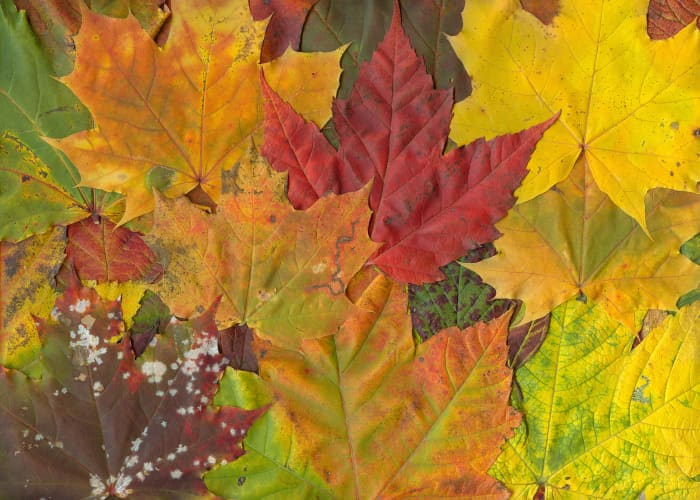Are Mulched Fall Leaves Good For Your Garden
Dolores has landscaped for private clients, maintained one client's small orchid collection, and keeps 30 houseplants.

This article will show you how to use leaf mold to improve the quality and health of your soil.
Micha L. Rieser, Wikimedia Commons
Fall is such a beautiful time of year: the clean, cool air, the final burst of flowers, and the brief, amazing glow of autumn leaves. Then they all turn brown and fall, littering the ground. It looks pretty at first, then becomes a nuisance. It seems like such a waste—all those gigantic trash bags full of dry leaves lining the streets. But no more. Don't waste fallen leaves when you can turn them into a helpful addition to your garden.
It is easy to convert dry leaves into a wonderful mulch and soil amendment for the garden. Shredded leaves, or leaf mold, can be mixed into the soil to loosen heavy clay, or you can spread it like mulch. It can be added to a container mix for outdoor potted plants. Containers dry out so quickly, but leaf mold helps retain moisture.
What Is Leaf Mold?
Leaf mold is made of shredded leaves and creates a carbon-rich mulch that improves soil texture and increases moisture retention. Turned into the soil of a new or older garden, leaf mold helps break up heavy clay soil and loosens sandy soil.
Leaf mold has a pleasant scent and has the additional benefit of being free! If you do not have many trees on your property, most neighbors will be happy to allow you to take theirs. Creating leaf mold is a sustainable practice, cutting down on waste and water usage.
Shredded leaves are not only useful, but the size of the leaf pile is drastically reduced. Once shredded, it is amazing how a giant pile is reduced to such a small amount. You can build a compost-type pile of shredded leaves that breaks down into a fine textured material that is useful in new or established gardens. You can also add it to an already existing compost pile.
- Rake the leaves into a low pile.
- Remove large sticks and debris.
- Run the lawn mower over the leaves until they are finely shredded.
- Dampen the pile. Do not make it soggy. A moist pile will break down more quickly than a dry one.
- Turn and fluff the pile occasionally about once a week, and you will have the leaf mold ready for use in the garden in six months. If you don't wish to aerate the pile every week, it will take longer.
Leaf mold does not need to heat up like regular compost. Even when compost does heat up, it may harbor weed seeds. Leaf mold, on the other hand, includes no weeds, so will not introduce them into your garden.
Read More From Dengarden

Make leaf mold out of shredded leaves.
Dolores Monet
Fallen Leaves Kill Grass and Attract Insects
Leaves left lying on the lawn can form a dense, soggy mat that not only becomes unsightly, but will kill the grass. Some leaves, such as oak leaves, are large and tough and break down very slowly.
If you do not wish to rake leaves off the lawn, run a regular lawn mower or mulching mower over them, shredding them into fine pieces. Shredded leaves break down quickly and encourage helpful fungi and earthworms. A small amount of shredded leaves can be left on the lawn, providing they are very finely shredded.
A large covering of dried leaves, even if they are shredded, may be too much to keep on the lawn. In that case, use the mower with a bag attached to collect leaf debris and create leaf mold.
Do not allow whole leaves to remain on the garden. Large leaves encourage insects. Rake dry leaves off the garden in late fall and through the winter. Certain trees do not drop all their leaves until early spring, so another raking will be necessary at that time.

Fallen leaves that aren't shredded can kill grass and attract insects.
Photo by snowpeak; downloaded by MPF on wikimedia commons; CCA
Leaf Mold Tips
- Bag It: If you do not want a pile of shredded leaves, you can dump them into a trash bag. Puncture the bag and add a shovel full of soil. Sprinkle a bit of water into the bag. Stir it up every so often to speed up the decomposition process.
- Use an Old Trash Can: A large trash can can be used the same way. Puncture holes in the sides of the can, dampen, and aerate.
- Corral It: Build a small cage. Use four posts (one at each corner) and wrap chicken wire around the pen. Fill it with shredded leaves, dampen, and aerate occasionally.
- Compost Leaves: Use the bagged or piled leaf mold in the compost bin. Leaf mold is brown matter. Layer it with green matter, such as the last grass cutting of the season.
- Azalea Food: Add conifer needles before shredding the leaves. Pine and other conifer needles create an acidic mulch that is ideal for azaleas, rhododendrons, and other plants that prefer an acidic soil
- Mulching With Leaf Mold: When adding leaf mold to the garden, do not crowd plants. Spread a 2–3" layer on the garden, avoiding plant crowns and stems.
- Avoid Black Walnut Leaves: They contain a chemical called juglone that can inhibit seed germination as well as nutrient uptake in flowers, vegetables, and some trees and shrubs.
- Avoid leaves from diseased or insect-infested trees.
This content is accurate and true to the best of the author's knowledge and is not meant to substitute for formal and individualized advice from a qualified professional.
© 2011 Dolores Monet
Are Mulched Fall Leaves Good For Your Garden
Source: https://dengarden.com/gardening/LeafMoldUseFallLeavestoImproveGardenSoil
Posted by: whatleyephimagent.blogspot.com

0 Response to "Are Mulched Fall Leaves Good For Your Garden"
Post a Comment